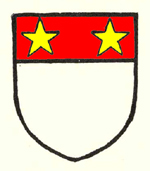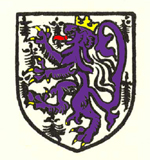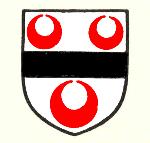Bletsoe Manor
Domesday Book
In the Domesday Book of 1086, a register of landholding in England compiled for King William I (1066-1087) Bletsoe was divided into two separate and equal sized holdings. Osbert de Breuil held 2½ hides from Hugh de Beauchamp and his manor contained seven villagers, two smallholders and two slaves. Eleven people is not many in half a village but these, of course, are just the heads of household and to reach the true figure one needs to multiply it by at least four - making around fifty people. The manor included a half share of a mill and woodland for a hundred pigs. It was worth sixty shillings, unusually the same value as before the Norman Conquest when it had been held by a man named Askell, though three freemen had also held an additional three virgates.
The other 2½ hides were held by Osbern from Countess Judith, niece of King William. His manor held six villagers, three smallholders and three slaves meaning that the whole vill probably held a little over a hundred people, making it a good sized community. Osbern's manor owned the other half share of the mill and also had woodland for a hundred pigs and, again, the value was sixty shillings. Before the Conquest this land had been owned by a woman called Leofeva who held it from King Edward the Confessor (1042-1066).

Saint John coat of arms
Overlordship
Hugh e Beauchamp, as noted above, was overlord of one manor in Bletsoe and Countess Judith of the other in 1086. Afterthis only one manor and one overlordship is mentioned in surviving documents.
John de Beauchamp died at the Battle of Evesham in 1265mand his mother Amicia held his overlordships until her death in 1278 when they were divided between John's three sisters Maud, Ela and Beatrice. The Manor Bletsoe passed to his sister Maud in 1278. Her first husband was Roger Moubray and his grandson, John, inherited the manor which remained in the Moubray family until at some point acquired by the Saint John family who held the overlordship as part of their barony in 1597, the last time it is mentioned in the surviving historical record. The seat of the manor was thus Bletsoe Castle.

Broy coat of arms
Tenancy
As noted above, there is no further mention of Countess Judith's manor in Bletsoe after 1086 and, consequently, no mention of her tenant Osbern's successors. The Victoria County History states that the Domesday tenant of the other manor, Osbert de Breuil's family held Bletsoe "for upwards of a hundred years". The first record of Bletsoe Manor is stated to be in the early 13th century when Robert de Broi, son of Walter, granted land in Bletsoe to the Hospital of the Holy Trinity in Northampton. The Broi/Broy family also owned land in Colmworth and other nearby parishes. At any rate in 1219 Robert de Broy and his son-in-law Walter de Pateshull disputed the ownership of the advowson of Bletsoe church with the Hospital.
Walter de Pateshull's son Simon was recorded as tenant of the manor under the overlordship of the Barony of Bedford between 1247 and 1253 when he gave land in Bletsoe to John de Berdefeud and others. The de Pateshulls held Bletsoe until 1359 when William de Pateshull left four sisters as co-heiresses and it was Sybil, wife of Roger de Beauchamp who received Bletsoe. The manor passed to the Saint Johns in 1421 when Margaret de Beauchamp, then aged eleven, inherited it. She married Sir Oliver Saint John and, after his death, John Beaufort, Duke of Somerset, to whom she bore Margaret Beaufort, mother of King Henry VII (1485-1509). When the elder Margaret died in 1483 John Saint John, the son she had with her first husband inherited Bletsoe and the manor remained with the family from that point onwards.
A survey of Bletsoe manor carried out for Sir Oliver Saint John in 1624 [WG10] reveals that the manor owned land in Bedford, Biddenham, Great Barford, Milton Ernest, Radwell, Riseley, Sharnbrook, Thurleigh and Wyboston as well as at least eight acres in Cold Newton in Northamptonshire, for which the total rent was four capons.
A succession of Law of Property Acts in the 1920s effectively ended manors in all but name. The acts took away the rights to hold manorial courts and abolished the tenure of copyhold by which manors had raised much of their income, ruling that all copyhold land had to be enfranchised as freehold.

de Pateshull coat of arms